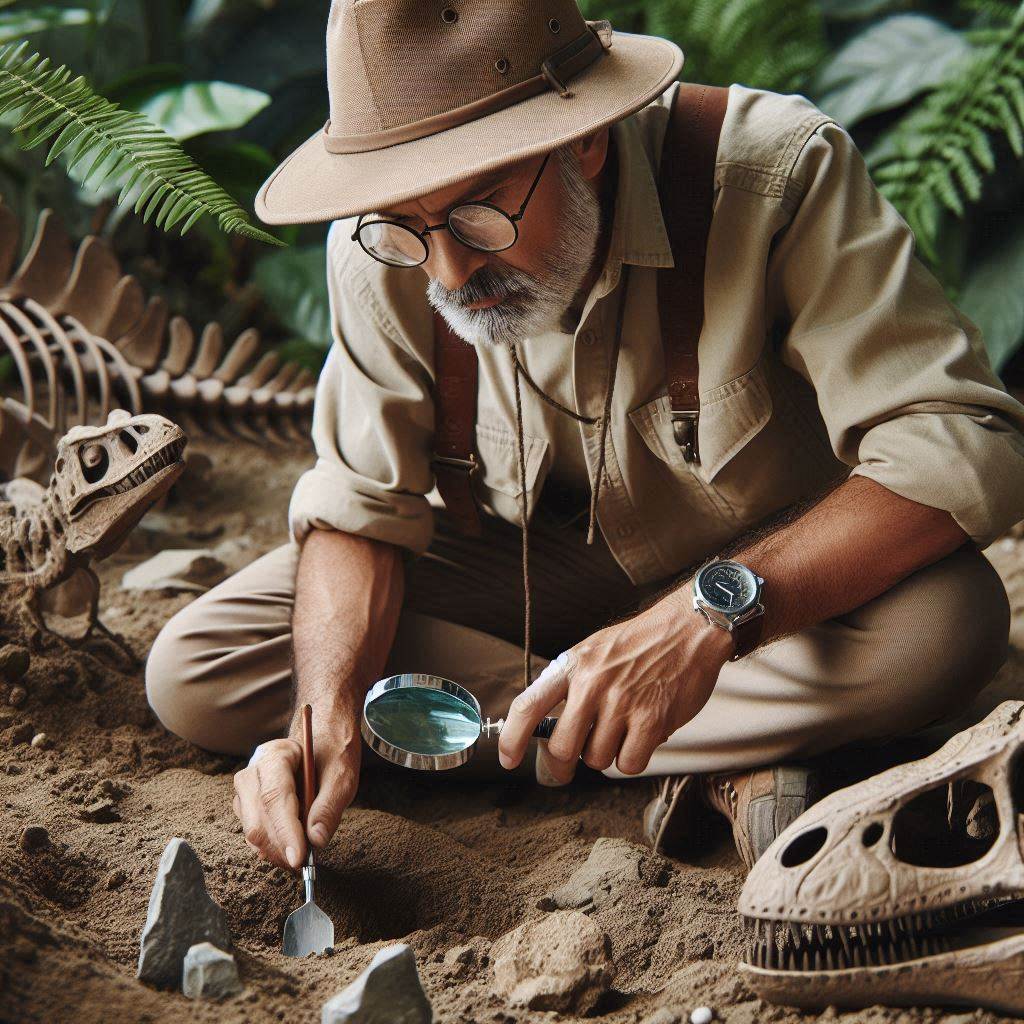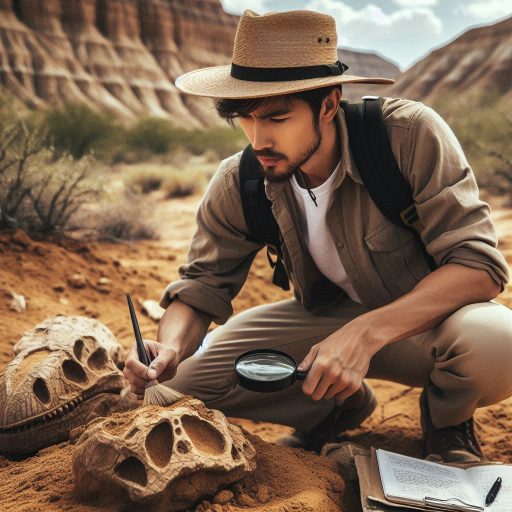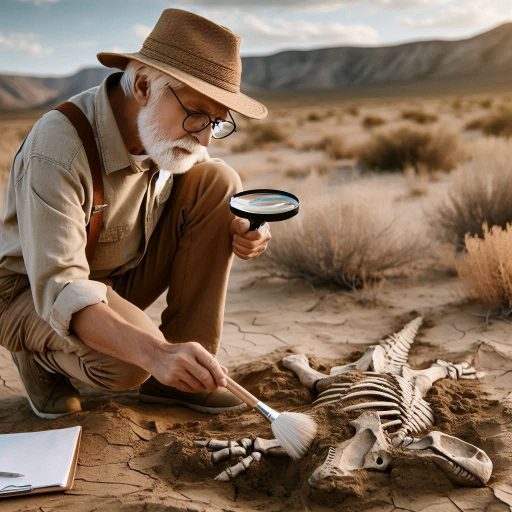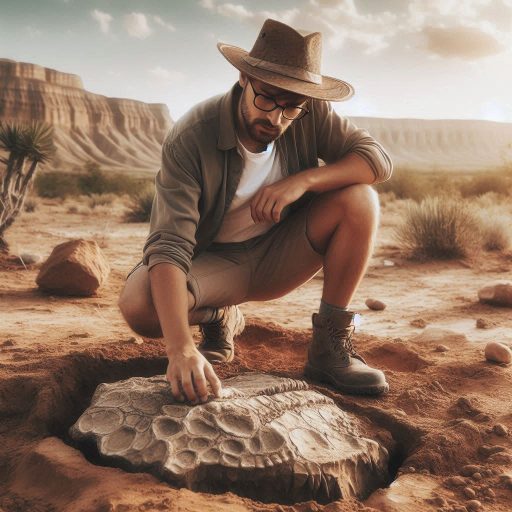Introduction
Paleontology is the scientific study of ancient life through fossils and geological evidence as paleontology earth history.
This field encompasses the analysis of past organisms and their environments.
By studying fossils, paleontologists uncover insights into the history of life on Earth.
Understanding Earth‘s history relies heavily on paleontological research.
Paleontology reveals how life has evolved over millions of years.
It provides context for understanding extinction events, climate changes, and the formation of ecosystems.
Fossils serve as vital records of biological diversity through time.
They help scientists reconstruct ancient habitats and track the changes that have occurred.
Paleontologists identify patterns in species‘ adaptations and migrations, revealing the impact of environmental shifts.
Moreover, paleontology informs current environmental challenges.
By studying past climate changes, researchers gain insights into potential future scenarios.
This knowledge is crucial for addressing today‘s pressing issues, such as biodiversity loss and climate change.
Paleontology plays a vital role in understanding Earth‘s history.
It provides a comprehensive view of how life has adapted and evolved over time.
Through fossil evidence, paleontologists contribute significantly to our understanding of biological and ecological processes throughout Earth’s history.
Brief history of paleontology
Development of Paleontology as a Scientific Discipline
Paleontology emerged as a scientific discipline in the early 19th century.
Scientists began systematically studying fossils to understand Earth’s history.
Early paleontologists, such as Georges Cuvier, laid the groundwork for this field.
Cuvier introduced the concept of extinction, which challenged prevailing beliefs about the permanence of species.
As fossil discoveries increased, so did interest in paleontology.
The study of fossils became crucial for understanding Earth’s geological past.
By examining fossils, scientists could reconstruct ancient environments and ecosystems.
This understanding helped connect biological evolution with geological changes.
In the late 19th century, paleontology gained recognition as a legitimate scientific field.
The establishment of societies and journals dedicated to paleontological research further advanced the discipline.
The introduction of techniques such as stratigraphy allowed paleontologists to date fossils accurately.
Today, paleontology continues to evolve, incorporating modern technologies like CT scanning and molecular analysis.
These advancements enhance researchers’ ability to study ancient life.
Paleontology now integrates with various fields, including geology, biology, and climate science.
This interdisciplinary approach enriches our understanding of Earth’s complex history.
Key Discoveries in Paleontology
Key discoveries in paleontology have profoundly shaped our understanding of Earth’s history.
The discovery of dinosaur fossils revolutionized perceptions of prehistoric life.
Early dinosaur findings in the 19th century sparked public interest in paleontology.
Notable discoveries like the Tyrannosaurus rex and Triceratops captured imaginations and showcased the diversity of ancient species.
Another significant discovery was the understanding of mass extinction events.
Research into the fossil record revealed multiple extinction events throughout Earth’s history.
The Cretaceous-Paleogene extinction event, which wiped out the dinosaurs, highlighted the impact of catastrophic changes.
This understanding has profound implications for biodiversity and ecosystem resilience.
Fossils of early hominids, such as Australopithecus and Homo habilis, provided insights into human evolution.
These discoveries illustrate the complex relationships between humans and other species.
Paleontology has helped trace the lineage of modern humans back millions of years.
The study of ancient climates through paleobotany has also shaped our understanding of Earth’s history.
Fossilized plants reveal information about past climates and environmental conditions.
By analyzing these plants, scientists can reconstruct historical climate patterns.
This knowledge aids in predicting future climate changes and their impacts.
Paleontology has also contributed to our understanding of the processes of evolution.
The fossil record documents the gradual changes that occur in species over time.
Key transitional fossils, such as Tiktaalik, illustrate the evolution of vertebrates from water to land.
These discoveries provide concrete evidence of evolution in action.
Paleontology has developed into a vital scientific discipline that shapes our understanding of Earth’s history.
Key discoveries, such as dinosaur fossils and evidence of mass extinctions, highlight the dynamic nature of life on Earth.
By studying ancient organisms and environments, paleontologists uncover the intricate story of our planet’s past.
This knowledge is essential for understanding current biodiversity and addressing future environmental challenges.
Read: US Chemistry Conferences and Symposiums to Attend in 2024
Role of fossils in paleontology
Definition of Fossils
Fossils are the preserved remains or traces of ancient organisms.
They can include bones, shells, and imprints left in sediment.
Fossils form when organic materials undergo mineralization or are buried in sediment.
Over time, sediment layers accumulate, preserving the remains of living things.
Fossils can also include traces of behavior, like footprints or burrows.
These trace fossils provide evidence of how organisms interacted with their environments.
Understanding these remnants helps scientists piece together the story of life on Earth.
Fossils can be classified into several categories.
Body fossils represent actual parts of organisms, such as bones or teeth.
Trace fossils record the activities of organisms, revealing their behaviors.
Microfossils, like pollen or plankton, offer insight into ancient ecosystems on a smaller scale.
How Fossils Provide Evidence of Past Life Forms and Ecosystems
Fossils serve as vital evidence of past life forms.
They reveal the diversity of species that once existed on Earth.
By studying fossilized remains, paleontologists can identify extinct species and their characteristics.
This process allows scientists to reconstruct ancient ecosystems.
Fossils also help scientists understand evolutionary processes.
By comparing fossils from different geological periods, researchers can trace changes over time.
This analysis provides insights into how species adapted to changing environments.
Fossils document the history of life, illustrating how organisms evolved and interacted.
Paleontology offers a window into ancient ecosystems and climates.
Fossils indicate the types of plants and animals that existed together.
By studying the layers of sediment surrounding fossils, scientists can determine environmental conditions.
For example, fossils found in coal deposits indicate lush, swampy environments.
Fossils also reveal patterns of extinction and survival.
Studying mass extinction events helps scientists understand the factors that led to biodiversity loss.
This knowledge is crucial for addressing current environmental challenges.
Fossils aid in reconstructing past climate conditions.
Isotopic analysis of fossilized remains can provide information about ancient temperatures and atmospheric composition.
Understanding these factors helps scientists predict future climate scenarios.
Paleontology plays a vital role in understanding Earth’s history through fossils.
These preserved remains provide invaluable evidence of past life forms and ecosystems.
By studying fossils, scientists uncover the evolution of life, extinction events, and ancient climates.
The insights gained from paleontology are essential for understanding our planet’s complex history.
As we explore the past, we gain valuable knowledge to inform our future.
Read: Key Roles and Responsibilities of a Chemist in the US
Methods used in paleontology
Excavation Techniques
Paleontology plays a vital role in understanding Earth‘s history through excavation techniques.
Excavation allows scientists to uncover fossilized remains buried in sediment.
Paleontologists use various methods to carefully remove fossils from their geological context.
Fieldwork often begins with thorough site surveys.
Researchers identify areas likely to yield significant fossil finds.
They analyze rock formations and sediment layers to determine their age and composition.
Once promising sites are located, paleontologists conduct systematic excavations.
During excavation, researchers use tools like brushes, shovels, and chisels.
These tools help minimize damage to delicate fossils.
They work slowly and meticulously to avoid breaking bones or other important structures.
Documentation is critical at this stage; paleontologists record the exact location of each find.
After excavation, fossils are transported to laboratories for further analysis.
Proper field techniques ensure that fossils retain important contextual information.
This information is crucial for understanding the environment in which the organisms lived.
Laboratory Analysis of Fossils
Laboratory analysis is essential for interpreting the information gathered during excavations.
Paleontologists carefully clean and prepare fossils for study.
They may remove excess matrix material to reveal the fossil‘s details.
Once prepared, fossils undergo various analyses to gather data.
Researchers examine the morphology, or structure, of the fossils.
This examination helps identify the species and understand its biology.
Paleontologists often conduct isotopic analysis to determine the chemical composition of fossils.
This information provides insights into the diet and habitat of ancient organisms.
Fossils can also yield clues about climate conditions during their time on Earth.
In addition, scientists use scanning electron microscopy to study the surface features of fossils.
This technique reveals microscopic details that are not visible to the naked eye.
Through careful laboratory analysis, paleontologists build a more comprehensive picture of Earth‘s history and the organisms that inhabited it.
Use of Technology
Advancements in technology significantly enhance paleontological research.
Tools like CT scans and 3D modeling have transformed the way scientists study fossils.
These technologies provide non-invasive methods for examining fossils.
CT scans create detailed cross-sectional images of fossils.
This imaging allows researchers to see internal structures without damaging the specimen.
By analyzing these images, paleontologists can understand the anatomy and health of ancient organisms.
3D modeling complements CT scanning by providing interactive visualizations.
Researchers can create digital models of fossils, allowing for virtual manipulations and simulations.
These models enable scientists to study the movement and biomechanics of extinct species.
Moreover, technology aids in preserving fossils digitally.
Creating 3D scans of fossils allows for their replication without the need for physical handling.
This preservation technique is especially useful for rare or fragile specimens.
In summary, paleontology plays a crucial role in understanding Earth‘s history through excavation techniques, laboratory analysis, and advanced technologies.
Excavation techniques ensure the careful recovery of fossils, while laboratory analysis reveals their biological significance.
The use of CT scans and 3D modeling enhances our ability to study and interpret fossils, enriching our understanding of ancient life and the Earth‘s past.
Read: Earning Potential: Chemist Salaries Across US States

Geological significance of paleontology
How Paleontologists Use Fossils to Interpret Past Environments and Climates
Paleontologists play a crucial role in interpreting Earth’s history through the study of fossils.
They analyze fossils to reconstruct past environments and climates.
Each fossil provides valuable clues about the organisms’ habitats and ecological conditions.
Fossils reveal information about ancient ecosystems, such as marine or terrestrial settings.
By examining the types of fossils found in specific layers, paleontologists infer the environment at that time.
For example, finding marine fossils in sedimentary rock indicates that an area was once underwater.
Additionally, fossils help scientists understand climate changes over geological time.
Specific organisms thrive in particular climate conditions.
By studying the distribution of these organisms, paleontologists can infer temperature and precipitation patterns.
Stable isotope analysis provides another tool for understanding past climates.
By examining isotopic ratios in fossilized materials, scientists can reconstruct ancient temperatures.
This technique offers insights into how climates shifted and affected life forms.
Paleontologists also study trace fossils, which include footprints and burrows.
These fossils provide clues about behavior and movement patterns in ancient environments.
By analyzing trace fossils, scientists gain a clearer picture of how organisms interacted with their surroundings.
Relationship Between Paleontology and Geology in Understanding Earth’s History
Paleontology closely relates to geology in understanding Earth’s history.
Geologists study the Earth’s physical structure, while paleontologists focus on the history of life through fossils.
Together, these fields provide a comprehensive view of past events.
Stratigraphy, a key aspect of geology, helps paleontologists date and correlate fossil findings.
Analyzing rock layers allows scientists to establish timelines for evolutionary changes.
Understanding the order of geological formations aids in interpreting the fossil record.
Moreover, geological processes, such as erosion and sedimentation, impact fossil preservation.
Knowledge of these processes helps paleontologists determine the likelihood of finding fossils in specific locations.
By understanding how rocks and fossils interact, scientists can reconstruct past environments more accurately.
Paleontology also informs geology about past life forms that influenced Earth’s systems.
For instance, the presence of certain plants indicates ancient climate conditions.
This information helps geologists understand how ecosystems have changed over time.
Furthermore, paleontological findings contribute to our understanding of major geological events.
Mass extinction events, for example, reveal significant changes in biodiversity and climate.
Analyzing the fossil record from these periods helps scientists assess the impacts on ecosystems.
Collaborative research between paleontologists and geologists enhances our understanding of Earth’s history.
Interdisciplinary studies offer new insights into how life and the planet interact.
This collaboration fosters a holistic view of Earth‘s past, revealing the intricate connections between organisms and their environments.
In short, paleontology plays a vital role in interpreting Earth’s history.
Through fossils, paleontologists reconstruct past environments, climates, and ecosystems.
The relationship between paleontology and geology further enhances our understanding of the planet’s evolution.
Together, these fields provide essential knowledge of the forces that have shaped life on Earth.
Read: Essential Skills and Tools for Modern Chemists in America
Explore Further: Ethical Dilemmas in Nuclear Science
See Related Content: Salary Expectations and Job Outlook for Paleontologists
Contributions of paleontology to evolutionary theory
Examples of Transitional Fossils
Transitional fossils provide crucial evidence for understanding evolutionary processes.
These fossils exhibit traits that bridge gaps between major groups of organisms.
One famous example is Archaeopteryx, a transitional fossil between dinosaurs and birds.
This ancient creature possessed feathers and wings, resembling modern birds while retaining dinosaur-like features.
Another significant transitional fossil is Tiktaalik, which represents the evolution of fish into tetrapods.
Discovered in the Canadian Arctic, Tiktaalik shows both fish and early amphibian characteristics.
It had fins with bone structures similar to those in limbs.
This adaptation indicates a shift towards life on land.
Australopithecus afarensis is another example, showcasing traits connecting early primates to modern humans.
Fossils like Lucy illustrate a mix of human-like and ape-like features.
They provide insights into bipedalism and the evolution of hominins.
These transitional fossils highlight the gradual changes that occur over millions of years.
Each discovery strengthens our understanding of evolutionary pathways.
By studying these fossils, scientists reconstruct the history of life on Earth.
How Fossil Records Support the Theory of Evolution
Fossil records offer extensive documentation of Earth’s biological history.
They provide chronological evidence of how organisms have changed over time.
By examining layers of sedimentary rock, researchers can determine the age of fossils.
This stratigraphy shows a clear timeline of evolutionary events.
Fossil records illustrate how species have adapted to changing environments.
For example, the evolution of horses demonstrates changes in size, tooth structure, and limb proportions.
These adaptations correlate with shifts in climate and available vegetation.
Additionally, fossil records reveal patterns of extinction and diversification.
Mass extinction events, such as the one that wiped out the dinosaurs, drastically altered ecosystems.
Subsequent recovery led to the rise of new species, illustrating the dynamic nature of evolution.
The presence of similar fossils in different geological strata supports the theory of common ancestry.
For instance, the existence of similar limb structures in whales and land mammals suggests shared origins.
This comparative anatomy reinforces the concept of descent with modification.
Paleontologists utilize fossil records to trace the lineage of various organisms.
By studying morphological changes, they can identify evolutionary relationships.
Molecular techniques, such as DNA analysis, further complement fossil evidence.
Fossil records also enhance our understanding of biogeography.
The distribution of fossils across continents provides insights into how species evolved in isolated environments.
For example, marsupials in Australia and placental mammals in other regions illustrate distinct evolutionary paths.
Transitional fossils and fossil records play a critical role in understanding Earth’s history.
They provide tangible evidence supporting the theory of evolution.
Each discovery enhances our knowledge of how life has evolved and adapted over millions of years.
By studying these fossils, we gain invaluable insights into the complex narrative of life on our planet.
Paleontology and mass extinctions
Study of Past Mass Extinction Events
Paleontology plays a crucial role in understanding Earth’s history, particularly during mass extinction events.
Throughout history, several mass extinctions have significantly altered life on our planet.
These events resulted in the loss of a large number of species in relatively short time frames.
Paleontologists study these extinctions to uncover patterns and causes.
The five most significant mass extinction events have shaped the course of evolution.
For example, the Permian-Triassic extinction eliminated about 96% of marine species.
Similarly, the Cretaceous-Paleogene extinction led to the demise of the dinosaurs.
Understanding these events helps us grasp how life on Earth has evolved over millions of years.
Paleontologists investigate geological evidence, such as rock layers, to identify extinction events.
They analyze changes in fossil diversity and abundance before, during, and after these crises.
This analysis provides insights into how ecosystems responded to drastic changes.
The fossil record serves as a timeline of life, highlighting when certain species thrived or perished.
How Paleontologists Use Fossil Records
Fossil records are invaluable for understanding the causes and impacts of mass extinctions.
Paleontologists examine specific layers of sedimentary rock to study fossil distribution.
By identifying fossilized remains, they can determine which species went extinct during mass extinction events.
To understand the causes of these extinctions, paleontologists look for patterns.
They investigate environmental changes, such as climate fluctuations or volcanic eruptions.
These events can lead to habitat loss and changes in species interactions.
For instance, the end-Permian extinction correlated with massive volcanic activity that released greenhouse gases.
Additionally, paleontologists study isotopic data from fossils to infer past climate conditions.
Changes in isotopic ratios can indicate shifts in temperature and ocean chemistry.
By understanding these changes, scientists can identify factors that contributed to mass extinctions.
Paleontologists also explore the ecological consequences of mass extinctions.
They study how surviving species adapted to new environments and evolved over time.
This research highlights the resilience of life and the interconnectedness of ecosystems.
The recovery periods following extinctions reveal how biodiversity can rebound after catastrophic events.
Transform Your Career Today
Unlock a personalized career strategy that drives real results. Get tailored advice and a roadmap designed just for you.
Start NowImpacts of Mass Extinctions
The impacts of mass extinctions extend beyond the loss of species.
They reshape ecosystems and alter evolutionary trajectories.
By examining these shifts, paleontologists gain insights into the processes driving evolution.
They can identify trends in adaptive radiation, where new species rapidly evolve to fill ecological niches.
Furthermore, understanding mass extinctions can inform current conservation efforts.
As modern-day threats, such as climate change and habitat destruction, loom large, paleontology offers valuable lessons.
By studying how past extinctions affected biodiversity, scientists can develop strategies to mitigate current challenges.
In a nutshell, paleontology is vital for understanding Earth’s history through the lens of mass extinction events.
By studying fossil records, paleontologists uncover the causes and impacts of these significant crises.
Their research reveals the resilience of life and informs our understanding of current ecological challenges.
As we face a potential sixth mass extinction, lessons from the past can guide our efforts to preserve biodiversity and protect our planet’s future.
Conclusion
Paleontology plays a vital role in uncovering Earth’s history.
It studies fossils to reveal how life has evolved over millions of years.
Each fossil tells a story about ancient organisms, their environments, and their interactions.
This knowledge helps scientists understand the processes of evolution, extinction, and climate change.
Through paleontological research, we gain insights into prehistoric ecosystems and biodiversity.
Such understanding allows us to recognize patterns and trends in Earth’s biological history.
Paleontology also sheds light on significant events, like mass extinctions and their impacts on life.
By studying these events, we can better understand how current species might respond to ongoing environmental changes.
Continued research in paleontology is essential for uncovering more about our planet’s past.
As technology advances, new methods allow scientists to analyze fossils and geological formations in innovative ways.
We must invest in this research to enhance our understanding of Earth’s complex history.
Moreover, supporting paleontological studies enriches our knowledge of current ecological challenges.
It also fosters appreciation for our planet’s rich biodiversity.
Therefore, we must encourage funding, education, and public engagement in paleontology.
By doing so, we can ensure future discoveries that deepen our understanding of Earth‘s dynamic history.
[E-Books for Sale]
The Big Book of 500 High-Paying Jobs in America: Unlock Your Earning Potential
$19.99 • 500 High-Paying Jobs • 330 pages
Explore 500 high-paying jobs in America and learn how to boost your career, earn more, and achieve success!
See All 500 High-Paying Jobs of this E-Book
1001 Professions Without a Degree: High-Paying American Jobs You Can Start Now
$19.99 • 1001 Professions Without a Degree • 174 pages
Discover 1001 high-paying jobs without a degree! Unlock career tips, skills, and success strategies for just $19.99!




